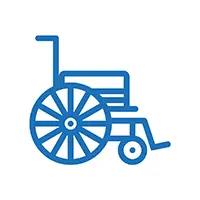Published 01 August 2019
Read the Living without barriers transcript
John Marrable decided he wasn’t going to let paraplegia stop him from doing anything.
Including earning a black belt in karate.
The Dunedin man, originally from England, believes there’s no limit to what people can accomplish.
He runs his own karate club in the Goju Ryu tradition.
“Get out there and live life to the fullest. That’s my motto.
“And never give up, really. That’s one of the mottos of our karate club. It’s so easy to stop because things get hard, but if you push through that barrier you can achieve so much.”
How karate works when you’re in a wheelchair
Karate normally involves a range of moves using the whole body, including kicks.
John can’t use his legs, so he compensates with other moves instead.
“When people are doing kicks I just carry on punching.
“We might do 500 kicks and then 500 punches, so I end up doing 1000 punches.
“We do patterns, so I try to get my wheelchair moving the same as someone would walk or move. You turn to the left I turn to the left, you turn 360, I turn 360.
“We do have a form where there’s a jumping kick but I don’t do that. I may do a wheelie, spin around. I try and emulate what people are doing, so if they kick I’ll do a hand technique instead.”
John says when he’s fighting, his opponent has an advantage because they only have to watch his hands.
The joy of teaching karate
As well as participating in karate, John also loves teaching it.
However, because he can’t demonstrate the moves, he often uses able-bodied people to stand-in for him to show how the moves are done.
“I do a lot of talking to explain, so I’ll tell you to have your feet shoulder-width apart, weight 60 percent on the ball of your feet, things like that.
“The buzz I get is just seeing the kids respond with me. They forget I’m in a wheelchair, which is really good.”
Discovering paraplegic sport
John lost the use of his legs at age 10 while on holiday in Scotland with his family.
“My parents told my brother and I not to go near this cliff. So, like really good boys we decided we’d go and climb it.
“Unfortunately, when I was on the way down, the cliff gave way. Ended up breaking my back and spending nine months in Stoke Mandeville Hospital.”
At that time, the Hospital had one of the best spinal units in the world. John spent nine months there undergoing rehabilitation.
He says it was there he learned the importance of being active, despite his impairments.
“Just about day one from when I was out of bed, they took me down to the gym and taught me table tennis and archery, and the following day, swimming.
“So, really all my paraplegic life I’ve been into sport.”
Finding karate
Initially, John wanted to learn Kung Fu.
“One of the things I really got into in the early 1970s was Bruce Lee movies, so I really loved the mind over matter attitude.”
He says he wanted to learn Kung Fu but he couldn’t find anyone to teach him in his wheelchair.
So, after arriving in New Zealand in 1974 with his family, he took up paraplegic sport. He began learning karate in 1976 after finding a club that would teach him in his wheelchair.
He’s been doing it ever since. He has a black belt at the 6th dan level.
“I just loved the idea of being fit both mentally and physically. I think the mind is the most powerful part of your body.”
The mind is the real barrier
As an accredited barrier-free advisor, John is highly skilled at evaluating environments to make sure they’re accessible.
He assesses buildings to make sure they meet accessibility criteria.
However, sometimes it’s not the building that’s the problem but the people, John says.
“You can have a perfectly accessible building but if the staff or the people in the building have got a negative attitude, they can make the experience bad for a person using the building,” John says.
“The biggest barrier’s the person themselves.
“I’ve seen lots of cases where someone has been born with a disability and as they’ve grown, they’ve learnt that there’s support for them.”
John says some people can become overly reliant on others to do things for them. This disempowers people because they learn not to do things for themselves.
“I think it’s good to be there but to help them but not do everything for them. Give them the skills to help themselves.”
John says these skills can be things like tricks and manoeuvres for people in wheelchairs, so they can be more independent.
For example, he says people can be taught to reverse down a flight of stairs in their wheelchair while holding on to the handrail.
When too much independence is a bad thing
Some people look at John and assume he needs help because he’s in a wheelchair.
But people that know him know that he’s extremely independent and can do pretty much everything himself.
However, it can work against him because when he really needs help with something, people assume he’s all right.
“I was at a pub one time and I pushed myself home from one end of Dunedin to the other, my car was in the garage.
“Different people were tooting thinking I was out doing my push at night, but I was thinking it would be great to get a lift home! So, sometimes it can be detrimental being so independent.”
John says as well as learning to be independent, disabled people should learn to ask for help when they need it.
He says some people struggle because they’re so determined to do something themselves.
However, it takes confidence to know when you really need help and ask for it.














